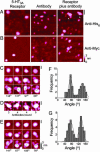Atomic force microscopy reveals the stoichiometry and subunit arrangement of 5-HT3 receptors
- PMID: 16116092
- PMCID: PMC1194916
- DOI: 10.1073/pnas.0503253102
Atomic force microscopy reveals the stoichiometry and subunit arrangement of 5-HT3 receptors
Abstract
The 5-HT3 receptor is a cation-selective ligand-gated ion channel of the Cys-loop superfamily. The receptor is an important therapeutic target, with receptor antagonists being widely used as antiemetics in cancer therapy. The two known receptor subunits, A and B, form homomeric 5-HT 3A receptors and heteromeric 5-HT 3A/B receptors. The heteromeric receptor has the higher single-channel conductance and more closely mimics the properties of the native receptor. We have used atomic force microscopy to study the architecture of 5-HT 3A and 5-HT 3A/B receptors. We engineered different epitope tags onto the A- and B-subunits and imaged receptors that were doubly liganded by anti-epitope antibodies. We found that, for the 5-HT 3A/B receptor, the distribution of angles between antibodies against the A-subunit had a single peak at approximately 144 degrees , whereas the distribution for antibodies against the B-subunit had two peaks at approximately 72 degrees and 144 degrees . Our results indicate that the subunit stoichiometry is 2A:3B and that the subunit arrangement around the receptor rosette is B-B-A-B-A. This arrangement may account for the difference between the agonist Hill coefficients and the single-channel conductances for the two types of receptor.
Figures




References
-
- Corringer, P.-J., Le Novère, N. & Changeux, J.-P. (2000) Annu. Rev. Pharmacol. Toxicol. 40, 431-458. - PubMed
-
- Karlin, A. (2002) Nat. Rev. Neurosci. 3, 102-114. - PubMed
-
- Lester, H. A., Dibas, M. I., Dahan, D. S., Leite, J. F. & Dougherty, D. A. (2004) Trends Neurosci. 27, 329-336. - PubMed
-
- Boess, F. G., Lummis, S. C. R. & Martin, I. L. (1992) J. Neurochem. 59, 1692-1701. - PubMed
-
- Boess, F. G., Beroukhim, R. & Martin, I. L. (1995) J. Neurochem. 64, 1401-1405. - PubMed
Publication types
MeSH terms
Substances
Grants and funding
LinkOut - more resources
Full Text Sources
Molecular Biology Databases

